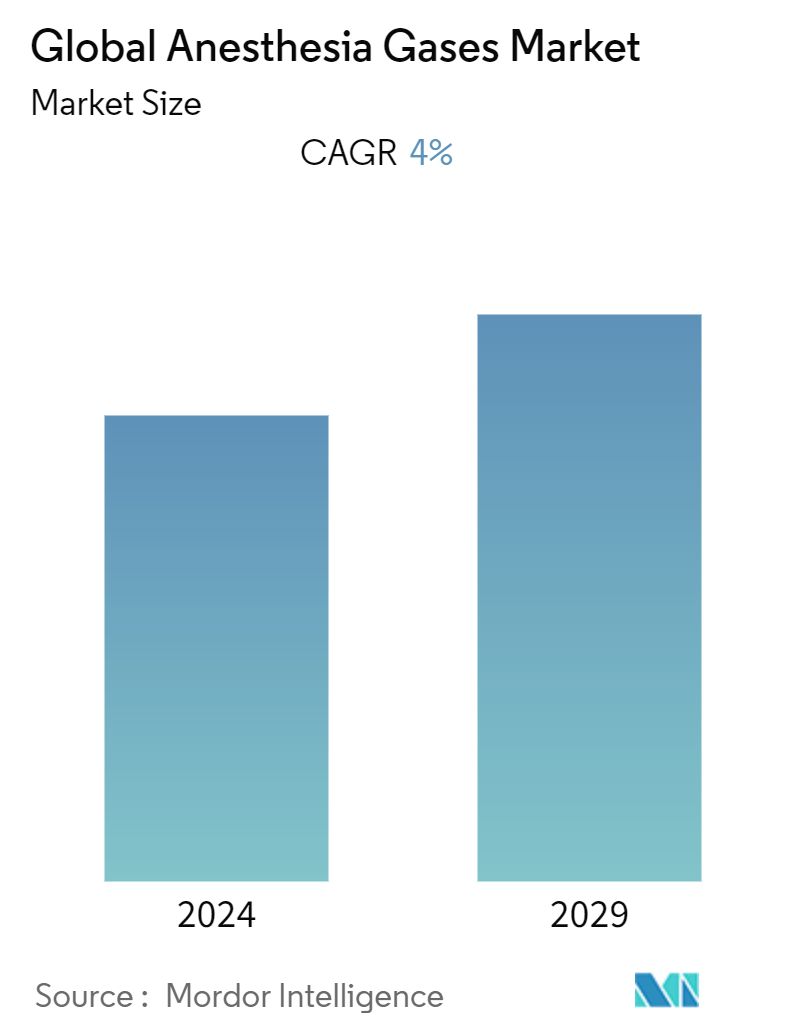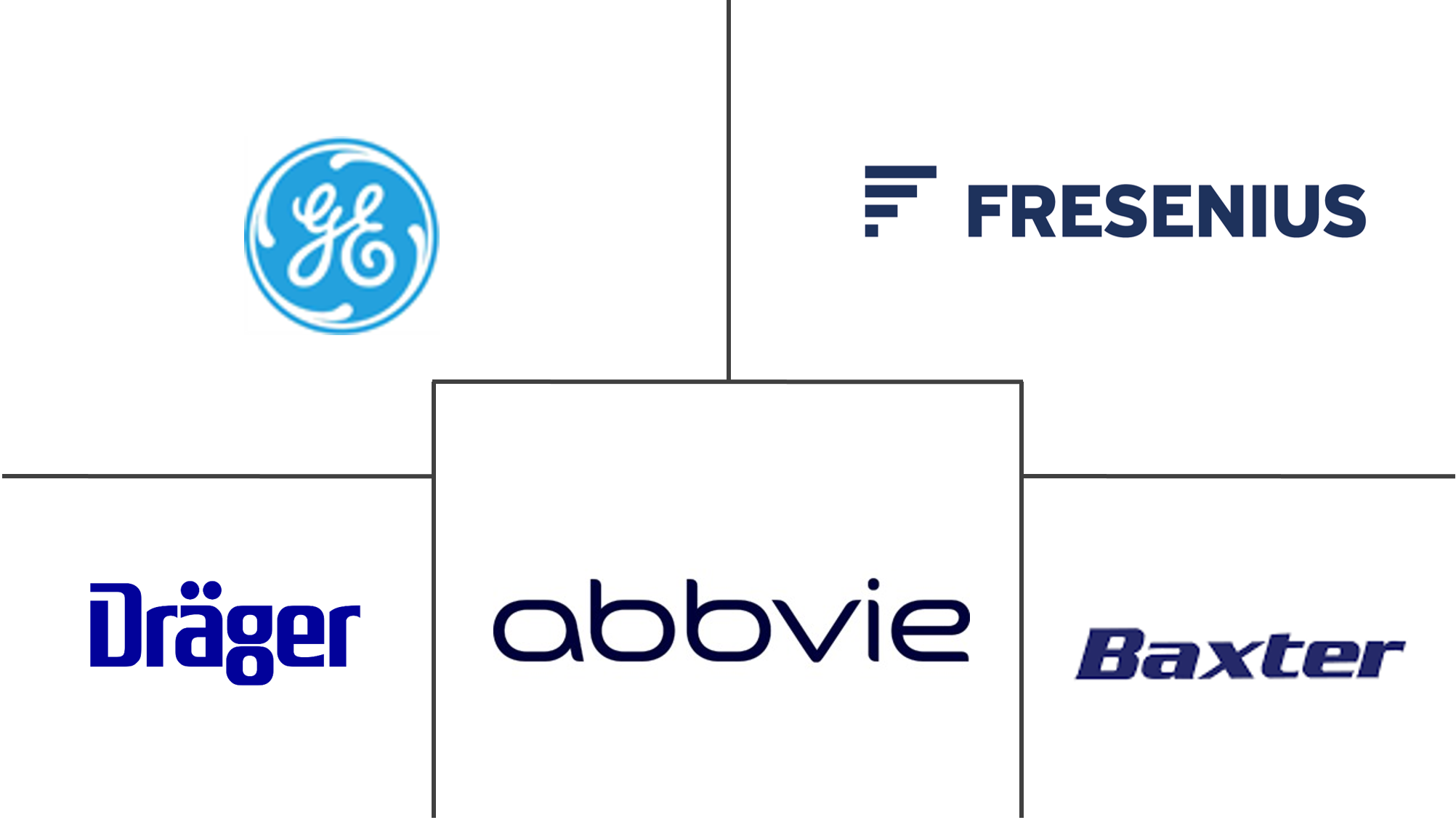Market Size of Global Anesthesia Gases Industry

| Study Period | 2019 - 2029 |
| Base Year For Estimation | 2023 |
| CAGR (2024 - 2029) | 4.00 % |
| Fastest Growing Market | Asia Pacific |
| Largest Market | North America |
| Market Concentration | Low |
Major Players
*Disclaimer: Major Players sorted in no particular order |
Anesthesia Gases Market Analysis
The Global Anesthesia Gases Market is expected to register a CAGR of 4% during the forecast period.
The increasing geriatric population who are prone to chronic diseases and the rising number of emergency cases are actively affecting the growth of the market studied as they need surgical interventions using anesthesia. According to the British Heart Foundation Factsheet, published in August 2022, about 7.6 million people in the United Kingdom had heart or circulatory diseases in 2022. As per the same source, it was observed that over half of the UK population is expected to experience a heart or circulatory condition during their lifetime. Notably, the number of individuals living with heart and circulatory diseases in the United Kingdom surpasses the combined count of those affected by cancer and Alzheimer's. Hence, the high number of patients suffering from cardiac diseases requiring cardiac surgeries is anticipated to fuel the demand for anesthesia gases in the market over the forecast period.
Furthermore, a significant increase in sports-related injuries, spinal cord injuries (SCI), and accidental fractures has driven the demand for surgical procedures, consequently boosting the utilization of anesthesia gases. For instance, according to the National Spinal Cord Injury Statistical Center report, in 2022, the annual incidence of traumatic spinal cord injury (SCI) was approximately 54 cases per one million people in the United States, which equals about 18,000 new SCI cases each year. The estimated number of people with SCI living in the United States last year was approximately 299,000, ranging from 253,000 to 378,000 persons. Thus, the high prevalence of sports-related injuries is expected to increase the demand for surgical procedures, boosting the usage of anesthesia gases.
Furthermore, increasing product recommendations and government acceptance of anesthesia gas usage are likely to boost the market growth. For instance, in November 2023, Sedana Medical AB stated that the European Medicines Agency's Paediatric Committee endorsed the company's Paediatric Investigation Plan, securing data exclusivity and market protection for Sedana Medical's Sedaconda (isoflurane) until 2031.
Therefore, with the rising prevalence of chronic diseases, rising surgical procedures, and product launches by key market players, the market studied is anticipated to grow over the analysis period. However, increasing generic anesthesia usage and side effects of anesthesia gases are expected to impede market growth over the forecast period.
Anesthesia Gases Industry Segmentation
As per the report's scope, anesthesia gases are used for the induction and maintenance of general anesthesia and sedation. The most common anesthesia gases are sevoflurane, desflurane, and nitrous oxide.
The anesthesia gas market is segmented by product type, end user, and geography. By product type, the market is segmented into anesthesia gases and vaporizer devices. The anesthesia gases segment is sub-segmented into desflurane, sevoflurane, isoflurane, nitrous oxide, and other anesthesia gases. By end user, the market is segmented into hospitals, ambulatory surgery centers, and other end users. By geography, the market is segmented into North America, Europe, Asia-Pacific, Middle East and Africa, and South America. The report also covers the estimated market sizes and trends for 17 countries across major global regions. The report offers market sizes and forecasts in terms of value (USD) for the above segments.
| By Product Type | |||||||
| |||||||
| Vaporizer Devices |
| By End User | |
| Hospitals | |
| Ambulatory Surgery Centers | |
| Others |
| Geography | ||||||||
| ||||||||
| ||||||||
| ||||||||
| ||||||||
|
Global Anesthesia Gases Market Size Summary
The anesthesia gas market is poised for stable growth, driven by factors such as the increasing geriatric population and the rising incidence of chronic diseases that necessitate surgical interventions. The market experienced a temporary setback during the COVID-19 pandemic due to the postponement of elective surgeries, but it is now recovering as surgical procedures resume. The demand for anesthesia gases is further bolstered by the growing number of emergency cases, including sports-related injuries and spinal cord injuries, which require surgical procedures. Product innovations and launches by key market players, such as Sedana Medical AB's introduction of Sedaconda, are also contributing to market expansion. However, the market faces challenges from the increasing use of generic anesthesia and potential side effects associated with anesthesia gases.
North America is expected to maintain a significant share of the anesthesia gas market, supported by a rising geriatric population and an increase in surgical procedures in the region. The prevalence of spinal cord injuries in the United States and Canada is anticipated to drive further demand for anesthesia gases. The market is characterized by a fragmented landscape with numerous international and local companies, including AbbVie Inc., Baxter, and Drägerwerk AG & Co. KGaA, holding substantial market shares. Initiatives such as Zimbabwe's National Surgical, Obstetric, and Anesthesia Strategy and Canada's focus on reducing the environmental impact of anesthetic gases highlight ongoing efforts to enhance surgical and anesthesia care. These developments are expected to support the growth of the anesthesia gas market over the forecast period.
Global Anesthesia Gases Market Size - Table of Contents
-
1. MARKET DYNAMICS
-
1.1 Market Overview
-
1.2 Market Drivers
-
1.2.1 Increasing Geriatric Population Prone To Chronic Diseases
-
1.2.2 Increasing Number of Emergency Cases
-
-
1.3 Market Restraints
-
1.3.1 Increasing Generic Anesthesia Usage
-
1.3.2 Side Effects of Anesthesia Gases
-
-
1.4 Porter's Five Forces Analysis
-
1.4.1 Threat of New Entrants
-
1.4.2 Bargaining Power of Buyers/Consumers
-
1.4.3 Bargaining Power of Suppliers
-
1.4.4 Threat of Substitute Products
-
1.4.5 Intensity of Competitive Rivalry
-
-
-
2. MARKET SEGMENTATION (Market Size by Value - USD)
-
2.1 By Product Type
-
2.1.1 Anesthesia Gases
-
2.1.1.1 Desflurane
-
2.1.1.2 Sevoflurane
-
2.1.1.3 Isoflurane
-
2.1.1.4 Nitrous Oxide
-
2.1.1.5 Other Anesthesia Gases
-
-
2.1.2 Vaporizer Devices
-
-
2.2 By End User
-
2.2.1 Hospitals
-
2.2.2 Ambulatory Surgery Centers
-
2.2.3 Others
-
-
2.3 Geography
-
2.3.1 North America
-
2.3.1.1 United States
-
2.3.1.2 Canada
-
2.3.1.3 Mexico
-
-
2.3.2 Europe
-
2.3.2.1 Germany
-
2.3.2.2 United Kingdom
-
2.3.2.3 France
-
2.3.2.4 Italy
-
2.3.2.5 Spain
-
2.3.2.6 Rest of Europe
-
-
2.3.3 Asia-Pacific
-
2.3.3.1 China
-
2.3.3.2 Japan
-
2.3.3.3 India
-
2.3.3.4 Australia
-
2.3.3.5 South Korea
-
2.3.3.6 Rest of Asia-Pacific
-
-
2.3.4 Middle East and Africa
-
2.3.4.1 GCC
-
2.3.4.2 South Africa
-
2.3.4.3 Rest of Middle East and Africa
-
-
2.3.5 South America
-
2.3.5.1 Brazil
-
2.3.5.2 Argentina
-
2.3.5.3 Rest of South America
-
-
-
Global Anesthesia Gases Market Size FAQs
What is the current Global Anesthesia Gases Market size?
The Global Anesthesia Gases Market is projected to register a CAGR of 4% during the forecast period (2024-2029)
Who are the key players in Global Anesthesia Gases Market?
AbbVie Inc., Baxter, Fresenius SE & Co. KGaA, Drägerwerk AG & Co. KGaA and GE Healthcare are the major companies operating in the Global Anesthesia Gases Market.

